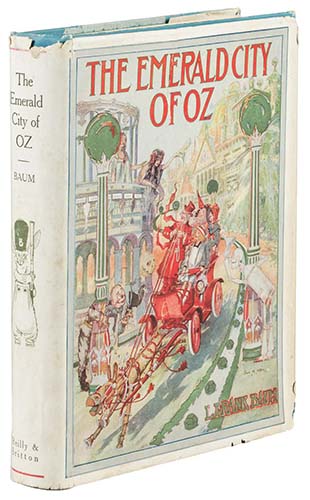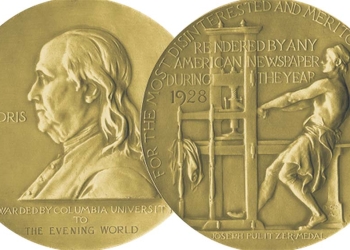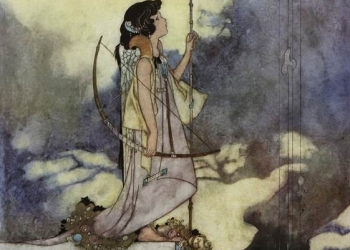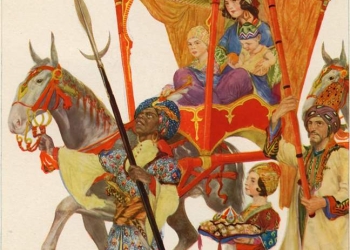Share via:
The Emerald City of Oz is the sixth of L. Frank Baum‘s fourteen Land of Oz books. Originally published on July 20, 1910, it is the story of Dorothy Gale and her Uncle Henry and Aunt Em coming to live in Oz permanently. While they are toured through the Quadling Country, the Nome King is assembling allies for an invasion of Oz. This is the first time in the Oz series that Baum made use of double plots for one of the books.
Baum had intended to cease writing Oz stories with this book, but financial pressures prompted him to write and publish The Patchwork Girl of Oz, with seven other Oz books to follow.
The Forbidden Fountain that Baum introduces in this book recurs in ensuing Oz books, by him and by his various successors. The Fountain is an important feature in The Magic of Oz (1919), The Forbidden Fountain of Oz (1980), The Wicked Witch of Oz (1993), and Paradox in Oz (1999).
Summaries

At the beginning of this story, it is made quite clear that Dorothy Gale (the primary protagonist of many of the previous Oz books), is in the habit of freely speaking of her many adventures in the Land of Oz to her only living relatives, her Aunt Em and Uncle Henry. Neither of them believes a word of her stories, but consider her a dreamer, as her dead mother had been. She is undeterred.
Later, it is revealed that the destruction of their farmhouse by the tornado back in The Wonderful Wizard of Oz has left Uncle Henry in terrible debt. In order to pay it, he has taken out a mortgage on his farm. If he cannot repay his creditors, they will seize the farm, thus leaving Henry and his family homeless. He is not too afraid for himself, but both he and his wife, Aunt Em, fear very much for their niece’s future. Upon learning this, Dorothy quickly arranges with Princess Ozma to let her bring her guardians to Oz where they will be happier and forever safe. Using the Magic Belt (a tool captured from the jealous Nome King Roquat), Ozma transports them to her throne room. They are given rooms to live in and luxuries to enjoy, including a vast and complex wardrobe, and meet with many of Dorothy’s old friends, including the Cowardly Lion and Billina the Yellow Hen.
In the underground Nome Kingdom, the Nome King Roquat is plotting to conquer the Land of Oz and recover his magic belt, which Dorothy took from him in Ozma of Oz. General Blug suggested that King Roquat have their forces dig a tunnel under the Deadly Desert. After ordering the expulsion of General Blug (who will not agree to such an attack due to the powers of Princess Ozma) and the death of Colonel (who also refuses) where he was sliced thin in a torture chamber and fed to a bunch of Seven-Headed Dogs, King Roquat holds counsel with a veteran soldier called Guph. Guph believes that against the many magicians of Oz (the reputation of which has grown in the telling), the Nome Army has no chance alone. He therefore sets out personally to recruit allies from other parts of Nonestica.
Dorothy, accompanied by the Wizard of Oz and several other friends, departs the Emerald City in a carriage drawn by the Wooden Sawhorse, intending to give her aunt and uncle a tour of the land. Many of the people encountered have never been seen in other books:
- The living cut-out paper dolls created by an immortal called Miss Cuttenclip.
- The anthropomorphic jigsaw puzzles known as the Fuddles.
- The loquacious Rigmaroles.
- The paranoid Flutterbudgets.
- The living kitchen utensils of Utensia.
- The anthropomorphic pastries of Bunbury.
- The civilized rabbits of Bunnybury.
- A zebra who holds geographical disputes with a soft-shell crab.
Other figures, more familiar to readers of previous books, include the Tin Woodman and the Scarecrow, as well as the four tribes of Oz (the Munchkins, the Quadlings, the Gillikins, and the Winkies).
The Nome General Guph visits three nations:
- The Whimsies are a large and hulking race, but possess disproportionately small heads the size of doorknobs. This causes other species to call them stupid, stripping them of any self-esteem. To deny this, the Whimsies wear enormous, luridly designed masks that cover all of their heads. Their Chief agrees to the deal and sends Guph on his way. The Chief of the Whimsies hopes that when the Nome King reclaims his Magic Belt, he can use its magic to make their heads the size of the masks they wear.
- The Growleywogs are muscular giants, possessing no surplus flesh and no mercy. They are arrogant and cruel. Their Grand Gallipoot agrees to the deal in exchange that they grant them 20,000 slaves from the Land of Oz. As such, they are eager not only to help the Nomes conquer Oz, but also to secretly subjugate the Nomes as well. Of the latter plan, they say nothing and send Guph on his way.
- Last of his meetings is that which is with the mysterious, diabolical Phanfasms of Phantastico. To Guph, the Phanfasms resemble hairy men, but having the heads of various carnivorous mammals, birds, and reptiles. Their true forms, number, standard of living, culture, and extent of influence remain unknown to both Guph and the reader, although both receive hints in the narrative. The first Phanfasm that Guph encountered was one with the head of an owl after getting passed the scarlet alligator on the bridge. Their bear-headed leader called the First and Foremost agrees to the deal so that they can make people unhappy. The Phanfasms tell him that they will conquer Oz alongside the other armies, but they have a secret plan to turn traitor and dominate their allies. Of the latter plan, they say nothing and send Guph on his way.
Having learned of this through Ozma’s omniscient Magic Picture, the people of Oz become worried. As the Nomes dig a tunnel for the combined armies to get under the Deadly Desert to the heart of the Emerald City, Ozma uses her Magic Belt to wish for a large amount of dust to appear in the tunnel. Upon emerging, the Nome King’s allies therefore drink thirstily from the nearby Fountain of Oblivion, whose waters make them forget their evil plans. The Nome King himself avoids the drink, but is thrown into the fountain by the Scarecrow and the Tin Woodman, which erases his memory too.
Ozma uses the Magic Belt to send the Nome King and his allies back to their respectful lands. To forestall a future invasion of Oz, Glinda the Good Witch uses a magic charm to render Oz invisible and unreachable to everyone except those within the land itself.
Frank Baum – The Emerald City of Oz First Edition Book Identification Points
Please refer to the gallery for detailed images of binding(s) and dust jackets.
| Year | Title | Publisher | First edition/printing identification points |
|---|---|---|---|
| 1910 | The Emerald City of Oz | Reilly & Britton Co., [1910] | First edition. Illustrated by John R. Neil, 196 pages. Four states: - 1 - Textual points: The publisher’s advertisement on the verso of the ownership page lists five titles: The Road to Oz, The Land of Oz, Ozma of Oz, Dorothy and the Wizard in Oz, and John Dough and the Cherub. Inserted pictorial endpapers in black and orange. Color plates: 16 full-color inserts embellished with metallic- green ink, tipped in facing the title page and pages 24, 54, 74, 108, 116, 136, 166, 186, 222, 232, 240, 258, 264, 282, 292. There are no typeset captions on the plates, although some have hand-lettered captions within the drawings. Binding: light-blue or dark-blue cloth. (Although dark-blue copies are rarer, no priority has been established.) On the front cover is a pictorial paper label showing a number of characters traveling through the city; the label is printed in colors and metallic green against a silver background. The spine is lettered in black with a picture of a rabbit in black and silver. The publisher’s name appears at the foot of the spine: “Reilly & | Britton”. Dust jacket: Issued in a full-color dust jacket with an illustration on the front which reproduces the label design, including the metallic green. The back panel reproduces, in different type, the publisher’s advertisement on the verso of the half-title page. The front and rear flaps are blank. Size of leaf: 9 by 6 3/4 inches. Thickness of volume'. 1 1/4 inches. Several copies have been reported with the imprint of the Copp, Clark Co., Limited, of Toronto. Except for the imprint on the title page and spine, this issue is identical with the American first state; most copies are bound in dark-blue cloth, but one copy has been reported in light-blue. Later Printings - 2 - Textual points: Same as #1 except that the book is printed on heavier paper stock, resulting in a volume about 1 3/8 inches thick. Color plates: Same as #1 except that in most copies the metallic-green ink is a duller shade. Binding: bright-green cloth, with a pictorial paper label on the front derived from designs used for the endpapers of Dorothy and the Wizard in Oz. The spine stamping is identical with that of the earlier binding. Textual points: Same as #s 1 and 2 except that the publisher’s advertisement lists titles through The Lost Princess of Oz (1917). Color plates: The number of color plates has been reduced to 12, and they lack the metallic-green embellishments. Binding: Same as #2. Textual points: Same as # 1, 2, and 3 except that the advertisement lists titles through The Tin Woodman of Oz (1918), and the endpapers are in black and white. Color plates: Same as #3. Binding: Same as # 2 and 3 except that there is no silver on the spine. SECONDARY BINDING: Copies made up of #3 sheets, including the Reilly & Britton title page, have been seen in light-green cloth with the publisher’s name on the spine: “Reilly & | Lee”. Subsequent printings of The Emerald City of Oz carry the Reilly & Lee imprint Copies are known with publisher’s advertisements through The Tin Woodman of Oz (1918), Glinda of Oz (1920), and The Hungry Tiger of Oz (1926); other copies presumably printed later have no advertisements. Copies printed in 1920 and later have typeset captions added to the color plates. In 1929, a third cover label and jacket design, by John R. Neill, replaced the old one and appeared on all printings up to around 1960. About 1935, the color plates were discontinued.
|
Frank Baum – The Emerald City of Oz Edition Dust Jacket Identification Points
First edition binding(s) and various Dust Jacket printings identification.
Reference:
- Wikipedia
- Bibliographia Oziana – Haff, Greeme, Martin. 2002











